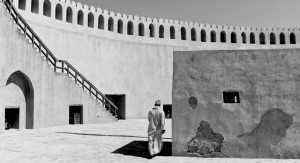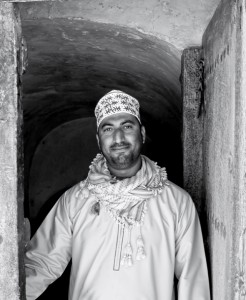In my pursuit of seeking out beautiful photographic locations and finding the perfect mix of coast and sun, I find myself heading for Oman. After much avid research on the country or rather Sultanate, I found that it met my current criteria of old-world architecture converging with the new.
It’s a long hot drive from Muscat (the coastal capital of Oman) to the town of Nizwa nestled amongst the Hajar Mountains. Driving across Oman’s barren stony interior, channelled by huge ‘wadis’ (dried-up river-beds which turn to raging rivers after heavy rains), the temperature slowly creeps from 30 to a steaming 35 degrees Celsius. Even the buzzing flies that have stubbornly evaded my attempts to banish them have given up and now lie motionless, craving cooler air.

Nizwa Fort, Hajar Mountains, Oman
Descending into a valley, Nizwa appears like an oasis surrounded by palms. My finger is excitedly poised on the shutter release as my eyes take in all that surrounds me commanding a strategic location at the crossroads of ancient caravan routes Nizwa Fort stands as an imposing bastion to would-be marauders in the 17th and 18th centuries. In this area, I’m told the much sort after Khalas and Khunaizi dates are grown. The sharp contrast between the darkness of the shadows and the powerfully strong sunlight makes for challenging times concerning settings, but the final result is well worth the struggle!

Qais Abdullah Mohammed Al-Hasni
My guide, Qais Abdullah Mohammed Al-Hasni sips from his water bottle having climbed to the highest point of the fort. Gazing westward toward the Empty Quarter, Qais tells of his Bedouin childhood and the serenity he once enjoyed living a simple lifestyle amongst the camels, sheep and goats in the desert. Like many Bedouin, Qais now lives in Muscat where his work provides for his family’s needs, materially at least. Spiritually he is fed by his memories of the desert.
A half hour’s drive from Nizwa and Jabrin Castle rises from the sun-scorched earth. Built-in 1675 as a summer residence for Sultan Bila’rab bin Sultan al-Yaarubi, a network of cooling corridors lead me to enchanting rooms crafted from local stone and plaster. Imported teak wood from India decorates the ceilings and in a beautiful atrium, mashrabiya windows cast intricate patterns on the surrounding walls. This is a striking place to shoot – there is such simplicity here, yet such beauty.
Returning to the bustling urban sprawl of Muscat, the modern facade leading to the Al Alam Palace offers a stark contrast to the peaceful rolling dunes we left behind earlier in the day. Home to His Majesty Sultan Qaboos, the palace basement reputedly houses a bowling alley!
During his reign, Sultan Qaboos has indisputably improved the lifestyle of many Omani people – health, education and employment indices all point to development and betterment, but where, I wonder, would Qais rather be?
Speak Your Mind